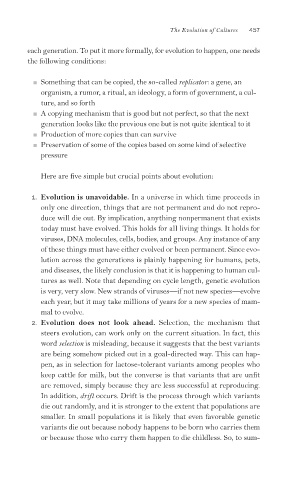Page 492 - Cultures and Organizations
P. 492
The Evolution of Cultures 457
each generation. To put it more formally, for evolution to happen, one needs
the following conditions:
■ Something that can be copied, the so-called replicator: a gene, an
organism, a rumor, a ritual, an ideology, a form of government, a cul-
ture, and so forth
■ A copying mechanism that is good but not perfect, so that the next
generation looks like the previous one but is not quite identical to it
■ Production of more copies than can survive
■ Preservation of some of the copies based on some kind of selective
pressure
Here are five simple but crucial points about evolution:
1. Evolution is unavoidable. In a universe in which time proceeds in
only one direction, things that are not permanent and do not repro-
duce will die out. By implication, anything nonpermanent that exists
today must have evolved. This holds for all living things. It holds for
viruses, DNA molecules, cells, bodies, and groups. Any instance of any
of these things must have either evolved or been permanent. Since evo-
lution across the generations is plainly happening for humans, pets,
and diseases, the likely conclusion is that it is happening to human cul-
tures as well. Note that depending on cycle length, genetic evolution
is very, very slow. New strands of viruses—if not new species—evolve
each year, but it may take millions of years for a new species of mam-
mal to evolve.
2. Evolution does not look ahead. Selection, the mechanism that
steers evolution, can work only on the current situation. In fact, this
word selection is misleading, because it suggests that the best variants
are being somehow picked out in a goal-directed way. This can hap-
pen, as in selection for lactose-tolerant variants among peoples who
keep cattle for milk, but the converse is that variants that are unfi t
are removed, simply because they are less successful at reproducing.
In addition, drift occurs. Drift is the process through which variants
die out randomly, and it is stronger to the extent that populations are
smaller. In small populations it is likely that even favorable genetic
variants die out because nobody happens to be born who carries them
or because those who carry them happen to die childless. So, to sum-

